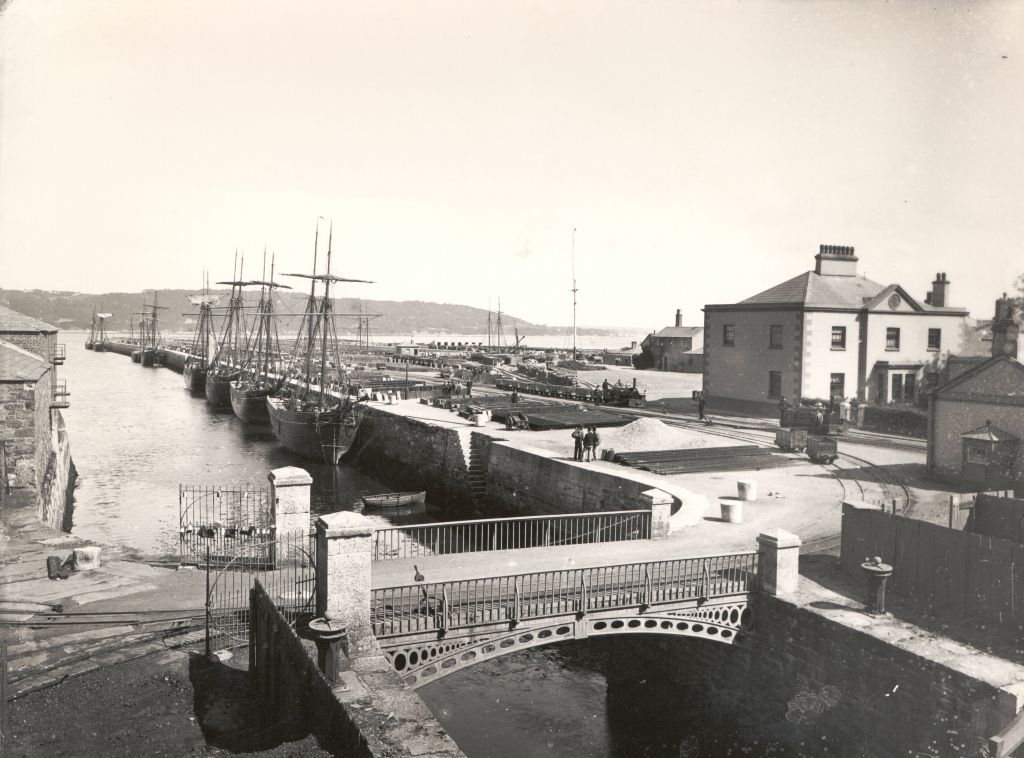Press Releases
SLATE TO THE SEA
Date:
2018-10-24A collection of archive photographs showing slate ready for export from some of the ports of north Wales

Penrhyn Port, Bangor ©Gwynedd Archive Service

Port Dinorwig Harbour

Slate boats by David Huntington
A new photographic exhibition at the National Slate Museum Llanberis looks at the relationship between slate and the sea.
As part of the 2018 celebration of Wales’s Year of the Sea, the exhibition – with photos from the museum’s own collections as well as a selection from the Royal Commission on the Ancient and Historical Monuments of Wales as well as Gwynedd and Conwy Archives Service - recalls some of the ports which were important to the slate industry in Wales - in particular to the exportation of slate around the world including Porth Penrhyn, Bangor, Slate Quay, Caernarfon, Porthmadog, Y Felinheli (Port Dinorwic) and Aberdyfi.
In 1882 the Welsh slate trade produced 280,000 tons of slate. This rose to 485,000 tons by 1898. Worldwide slate exports from Welsh ports were enormous and included the West Indies (114 Tonnes) Argentina (404 Tonnes) Channel Islands (580 Tonnes) British South Arica (290 Tonnes) Belgium (431 Tonnes) Germany (41,000 Tonnes) Denmark (3,500 tonnes) and Australia (5,500 tonnes)
The busy ports serving the slate industry included Porthmadog where initially, slate was carted from Blaenau Ffestiniog down to the quays along the Afon Dwyryd, then boated to Porthmadog for transfer to seagoing vessels. The rapidly expanding cities of England needed high quality roofing slate, which gave rise to railways to transport them to the new port by tramway from the quarries around Ffestiniog and district. The Ffestiniog Railway opened in 1836, followed by the Croesor Tramway in 1864 and the Gorseddau Tramway in 1856, and by 1873 over 116,000 tons (117,800 t) were exported through Porthmadog in more than a thousand ships.
Another port which features in the exhibition is Y Felinheli – transformed by slate quarrying when the Assheton Smiths – the owners of Dinorwic quarry and the Vaynol Estate - built the harbour to export slate transported to the quay by the Dinorwic Railway, a narrow gauge railway (now the Llanberis Lake Railway). They also decided to give Y Felinheli the alternative name of Port Dinorwic at that time!
The slate quay at Caernarfon served the development of the Nantlle quarries when new wharves were constructed along the Seiont to cater for the growing output of slate, mostly to be transported to customers by ships. The arrival of the Nantlle Railway in 1826 boosted slate exports from Caernarfon. By 1840 the slate quay become the main focus of Caernarfon’s shipping activity.
Another thriving slate port was Porth Penrhyn in Bangor which served the Penrhyn Quarry at Bethesda. Although today slate production and exports are not at 19th century levels it continues to be a key part of the business of slate. Exports of crushed slate (aggregate) by Penrhyn Quarry, through Porth Penrhyn to Rotterdam, or ports along the south coast of England, have grown to become a significant proportion of Welsh Slate sales in addition to several containers of roofing slates being shipped every month to Australia alone (taking approximately 45 days).
Welsh slate is now covering the roofs of buildings as prestigious as the New South Wales Supreme Court and historic as Unwin’s Stores, both in Sydney Australia, as well as the Arts Centre in earthquake-hit Christchurch, New Zealand 2012. Europe is also a prime destination for Welsh slate with shipments of slate and decorative aggregate within Europe continuing to grow and evolve in particular. In 2017 a total of seven shipments totalling almost 14000 tonnes of slate aggregate were made from Port Penrhyn in Bangor*.
Also featuring in the exhibition are 4 small ships made of slate - built of slate with sails made from copies of some of the archive photographs and OS maps of the area. They have been made by David Huntington of Anglesey.
The photographs can be seen until 31.12.2018 and admission is FREE.
For more information visit www.amgueddfa.cymru | www.museum.wales @amgueddfalechi #yearofthesea